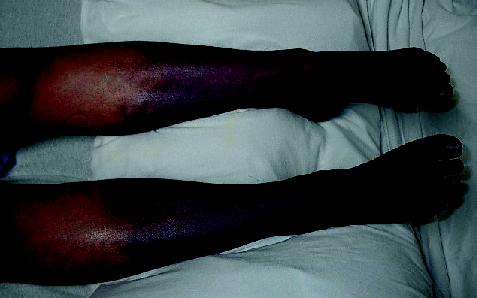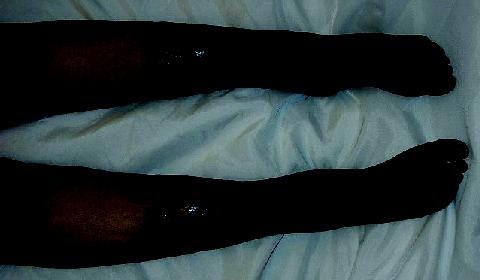A 31-year-old woman presented to the hospital with a 3-week history of malaise and dyspnea. Bilateral pulmonary infiltrates were seen on a chest radiograph, and laboratory testing indicated that she had renal failure (serum creatinine 400 μmol/L), urine sediment (red cell casts), an elevated erythrocyte sedimentation rate (110 mm/h) and marked anemia (hemoglobin 64 g/L). A kidney biopsy specimen showed immune-complex necrotizing glomerulonephritis with advanced glomerulosclerosis. The C3 level was slightly low, and serologic testing revealed antinuclear antibody (titre 1:80), with no antineutrophil cytoplasmic autoantibody or antiglomerular basement membrane antibody. Lupus-like immune-complex nephritis was diagnosed, and the patient was given prednisone and cyclophosphamide as well as trimethoprim–sulfamethoxazole prophylaxis.
The pulmonary infiltrates resolved, but the kidney disease progressed and she required hemodialysis. One month later febrile neutropenia developed (leukocyte count 0.4 х 109/L) and hypotension (blood pressure 70 mm Hg), and she presented again to hospital in septic shock. She was treated with intravenous fluids, antibiotics (ceftazidime), inotropes (dopamine, levophed), mechanical ventilation and dialysis. Overwhelming disseminated intravascular coagulation (DIC) developed on her third hospital day, and blood cultures subsequently grew Pseudomonas aueroginosa. She was given intravenous heparin therapy, which had to be stopped after 48 hours because of bleeding from mucosal surfaces (nostrils, endotracheal tube and gums). Four days after admission a bluish discoloration appeared on both legs, about 8 cm below the knee joints (Fig. 1). Intra-arterial chlorpromazine therapy, topical nitrate therapy and intravenous epoprostenol infusion failed to improve circulation to her legs (Fig. 2, at 34 days). An angiogram revealed almost no circulation about 10–12 cm below the knee joints, save for mild soft-tissue blush, and eventually the patient underwent bilateral below-knee amputations.

Figure 1. Photo: Images courtesy Dr. Malvinder Parmar

Figure 2. Photo: Images courtesy Dr. Malvinder Parmar
Symmetrical peripheral gangrene (SPG) is a rare but devastating complication of septicemia, with a high mortality (up to 40%). About half of the patients who survive require amputation of the affected limb.1 The common organisms involved are Pneumococcus, Staphylococcus and Streptococcus, but gram-negative organisms have also been implicated.2 SPG can also occur as a complication of malignant disease (paraneoplastic syndrome), ergotism or protein C deficiency. Up to 85% of patients with SPG have associated disseminated intravascular coagulation.1 Aggravating factors include asplenia,3 immunosuppression,1 previous cold injury to extremities,4 diabetes mellitus,5 renal failure,6,7 increased sympathetic tone5 and use of vasopressors.1,4,7
Pinpointing the cause of the vascular occlusion is difficult, but a low-flow state is present in most cases. SPG should be suspected at the first sign of marked coldness, pallor, cyanosis or pain in the extremity, as the condition can progress rapidly to acrocyanosis and, if not reversed, frank gangrene. The ischemic changes begin distally and may progress proximally to involve the entire extremity. These changes are not ordinarily preceded by demonstrable peripheral vascular occlusive disease and may be associated in the early stages with intact distal pulses because the large vessels are often spared. The low-flow state results in occlusion of the microcirculation of the affected parts. Pathologic examination of amputated specimens often reveals thrombi concentrated in the small vessels and not the large vessels. Hence, preoccupation with distal ischemic changes should be avoided, and attention should be focused on correcting the underlying cause(s) of the ischemic phenomenon.
No treatment is universally effective. Early recognition and immediate discontinuation or reduction, if possible, of vasopressor therapy (as it aggravates the low-flow state by enhancing vasoconstriction) and vigorous therapy of sepsis and DIC with intravenous antibiotic therapy and heparinization1,3 (if feasible) are essential components of SPG management. Other measures that might be helpful are sympathetic blockade4,5 (ganglion block or intravenous trimethaphan therapy), intravenous nitropruside therapy,8 topical nitroglycerine9 ointment, local or intravenous infusion of an α-blocker (phentolamine, chlorpromazine) and intravenous infusion of prostaglandin (epoprostenol).4,8,10 Papaverine, reserpine, streptokinase, dextran and hyperbaric oxygen therapy have not been shown to be of value.1,5 Amputation of the gangrenous area may be inevitable, but it is rarely required urgently.5 An initial nonsurgical approach allows time for the patient's condition to stabilize and the gangrene to become demarcated.
Malvinder S. Parmar Department of Internal Medicine, Timmins and District Hospital Timmins, Ont.
References
- 1.Molos MA, Hall JC. Symmetrical peripheral gangrene and disseminated intravascular coagulation. Arch Dermatol 1985;121:1057-61. [PubMed]
- 2.Rintala E, Kauppila M, Seppala OP, Voipio-Pulkki LM, Pettila V, Rasi V, et al. Protein C substitution in sepsis-associated purpura fulminans. Crit Care Med 2000;7:2373-8. [DOI] [PubMed]
- 3.Stossal TP, Levy R. Intravascular coagulation associated with pneumococcal bacteriemia and symmetrical peripheral gangrene. Arch Intern Med 1970;125:876-8. [PubMed]
- 4.Hayes MA, Yau EH, Hinds CJ, Watson JD. Symmetrical peripheral gangrene: association with noradrenaline administration. Int Care Med 1992;18:433-6. [DOI] [PubMed]
- 5.Johnson K, Hansen ST Jr. SPG (purpura fulminans) complicating pneumococcal sepsis. Am J Surg 1993;165:642-5. [DOI] [PubMed]
- 6.Goodwin JN, Berne TV. Symmetrical peripheral gangrene. Arch Surg 1974;108:780-4. [DOI] [PubMed]
- 7.McGouran RC, Emmerson GA. Symmetrical peripheral gangrene. Br Heart J 1977;39:569-72. [DOI] [PMC free article] [PubMed]
- 8.Joynt G, Doedens L, Lipman J, Bothma P. High-dose adrenalin with low systemic vascular resistance and symmetrical peripheral gangrene. S Afr J Surg 1996;34:99-101. [PubMed]
- 9.Coakley J. Nitroglycerin ointment for dopamine-induced peripheral ischaemia [letter]. Lancet 1983; 2:633. [DOI] [PubMed]
- 10.Leaker B, Miller R, Cohen S. Treatment of acute renal failure, symmetrical peripheral gangrene, and septicaemia with plasma exchange and epoprostenol [letter]. Lancet 1987;1:156. [DOI] [PubMed]


